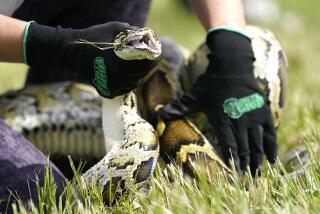Earthwatch: A Diary of the Planet
- Share via
Eruptions
One of the 72 remaining giant tortoises on Ecuador’s Galapagos Islands was killed by the ongoing eruption of Cerro Azul Volcano. National park officials on the island of Isabela said the body of the tortoise was found burned by a lava flow. An aerial survey of the tortoise population during the previous week has enabled officials toevacuate some of the reptiles. On the Ecuadorean mainland, residents of Quito scrambled to buy gas masks and canned food after authorities warned that the nearby Guagua Pichincha Volcano was showing signs of erupting. Authorities declared a “yellow alert” 5/8 and warned residents to be vigilant during the coming “weeks or months.”
Earthquakes
The second strong earthquake to strike western Iran’s Ilam province in two days destroyed at least 100 residential buildings. In southern Peru, a moderate quake caused walls to collapse near Arequipa Earth movements were also felt in Yugoslavia, Greece, China, New Zealand and Japan’s southern islands.
Heartland Storms
An outbreak of severe weather spread slowly across the heartland of the United States, producing an outbreak of tornadoes, severe thunderstorms and flash flooding. One in a string of tornadoes in Oklahoma wrecked the downtown business district of Prague, where 13 people were injured. Fierce storms that deluged the Kansas City area swept away cars, collapsed a bridge and left nine people dead and three others missing. More than half a foot of rain turned streets into rivers.
Nuclear Contamination
The weekly Der Spiegel reported that spinach grown near the nuclear reprocessing plant in Sellafield, England, shows traces of radioactivity seven times higher than normal. The German magazine based its report on research by British scientists that shows the doses of technetium-99 exceeded the European Union standard for food products by seven times. The environmental group Greenpeace has blamed the facility for “incredible radioactive contamination” in the soil and in the Irish Sea around the plant.
Turtle Release
Mexico’s Guerrero State Autonomous University released 2,500 baby sea turtles into the Pacific Ocean at Acapulco. The university’s Marine Ecology School director, Juan Vivantes Gonzales, said that a total of 22,115 turtle eggs have been processed in the turtle nursery so far this year. He expects that the hatchlings will eventually migrate back to where they were released to lay their own eggs. Every year, breeding turtles arrive on the beaches around Acapulco, and biologists have long proposed that the Barra Vieja area should be declared a zoneof protection for the endangered marine animals.
*
Additional Sources: U.S. Climate Analysis Center, U.S. Earthquake Information Center and the World Meteorological Organization.
More to Read
Sign up for Essential California
The most important California stories and recommendations in your inbox every morning.
You may occasionally receive promotional content from the Los Angeles Times.










